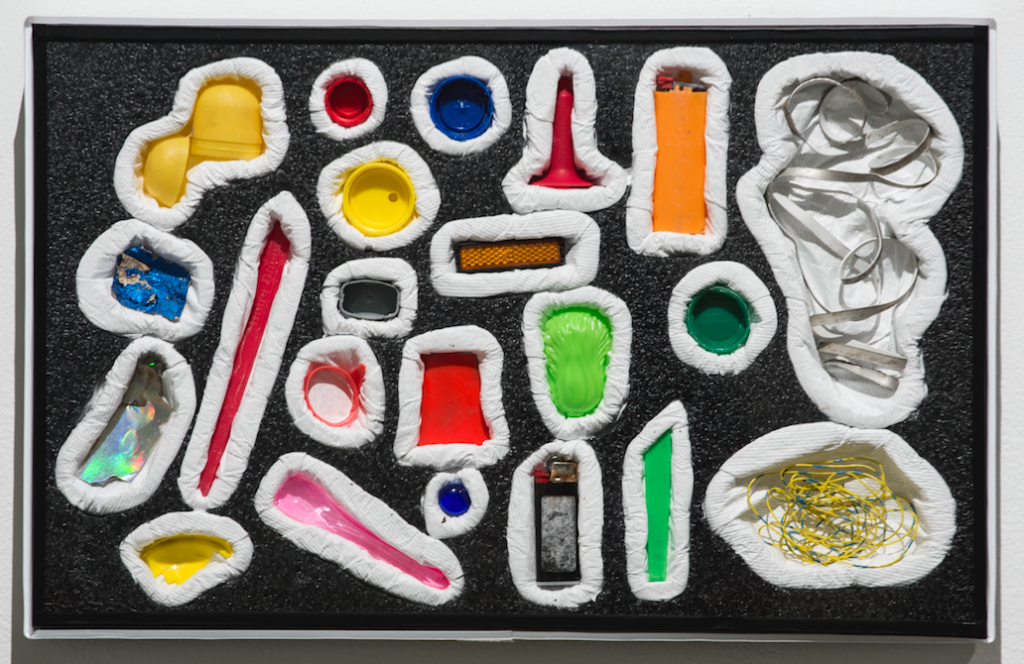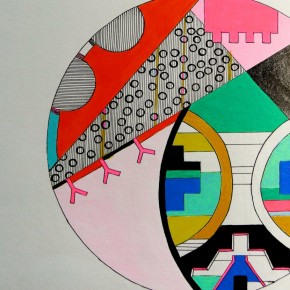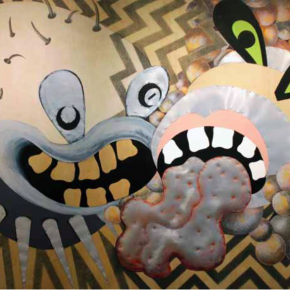Archives, be they official, governmental or familial, serve not only as a record of the past, but as an entryway into it; Aged maps, faded photographs and volumes of official records of life and death allow us to piece together and connect with places and people we may have never known. L’Acadie Mythique, a travelling exhibition that recently visited the Saint Mary’s University Art Gallery, is curated by Harlan Johnson and features nearly twenty different artists from across the Acadian diaspora. The show explores the Acadia of past and present by inviting artists to consider and respond to items from local archives. The resulting works, produced by artists from Atlantic Canada, Quebec, Maine and Louisiana, reveal another facet of the power of archival collections: they can become part of a conversation, a tool for thinking about and exploring place, identity and culture in the contemporary world.

Paul Édouard Bourque, Untitled, 2014. Mixed media on board, 40 x 60 cm. Photo: Steve Farmer (detail)
Some of the clearest examples of the evolving history and understanding of the Acadian culture can be found in some of the artists’ treatment of one of its most popular and beloved symbols: Évangéline. Longfellow’s tragic titular heroine has become an enduring symbol of Acadia, despite the fact that the fictional young woman was the creation of an American poet who had never set foot in the places described in the epic poem. Alisa Arsenault’s Évangéline Ostie takes an arch, even cheeky look at Évangéline as a cultural symbol, transposing her image, in delicate pink, onto a communion wafer— itself another potent symbol of significance to Acadian culture. Described by the artist as “a work exploring the commercialization of the mythological Acadian figure Évangéline,” the wafers and a mock-commercial for the “product” cleverly skew the commodification of an icon.
Paul Édouard Bourque’s untitled works engage with Évangéline and religion in a more deeply personal way, rendering her as a sort of neon saint. A small plastic case, full of tiny plastic objects, is one of the first pieces you encounter upon entering the gallery. Bourque re-imagines Évangéline’s journey as what Johnson describes as a sort of “ecological parable, a contemporary re-interpreting”; the artist imagines disoriented Évangéline desperately mistaking these bits of refuse for food, slowly filling her stomach with detritus until it kills her. Less playful than Arsenault’s take, it is a dark, somehow even more tragic exploration of an already devastating story.
The story of Acadia and Acadians is the story of land and borders, and the artists involved in this show tackle this in a myriad of ways. Maps figure in heavily, and the ways in which many of the artists present them as obscured and fragmented speaks to a complex history of displacement and disruption. The exhibition was inspired in part by Johnson’s own artistic explorations into the world of mapping. He’s included these works in the exhibition, which feature fragments of maps nautical charts, collaged alongside iconic images and objects like an image of Christ, a dyke shovel and hand-written church records of births, baptisms and deaths. Some are covered with a translucent polyester sheet, slightly obscuring the images underneath; this, Johnson explains, is no coincidence.
That choice “speaks a little bit about history, something that’s not completely transparent—it’s somewhat opaque and takes a certain effort to see through it. The shovel, it’s a dyke shovel, which is kind of like about the founding but also the finding of what Acadia is; you have to dig for it, and it was also based on digging in the beginning.”
Works by Carol Pelletier and Rebecca Belliveau also engage with maps, recreating and desecrating them, emphasizing a fractured sense of place and a history of uncertainty and loss. These pieces use hand-drawn and heavily altered and obscured maps, along with familiar associated images like the Virgin Mary and flowing water, in a destabilizing manner. Through asserting specific, personal relationships to official documents, the artists render them at once familiar and alien to their audience.
Becka Viau’s À la recherche des forêts qui répètent l’écho de l’Acadie / Seeking the woods that echo Acadie can be understood as a sort of encapsulation of the exhibition itself. Projected onto two perpendicular walls is a video of two snowsuit-clad figures standing in a snowy forest-scape. Their voices echo “Acadie,” calling out and overlapping one another. Viau explains the significance of the echo as “a metaphor of reciprocity”—one that “… evokes a sense of relatedness between man and non-man; the transcen- dental relation between civilization and nature.” Viau says: “An echo is located somewhere in the middle ground, in-between that space where things are tangibly lost but continually articulated.” L’Acadie Mythique itself is something of an echo; voices from across the diaspora call out to the past and to each other. The works engage simultaneously with the past and the present, expressing the diversity of the loosely shared experience of Acadian myth and culture. Engaging with archival materials, the works point to the past and future simultaneously, echoing Acadie across time and space.
















I attended the opening reception for this show, and very much enjoyed the presentations by the artists who attended. I was impressed that nearly all valiantly spoke in English – my schoolgirl French is not up to understanding a serious presentation in French! I suspect that one American artist was an Anglophone – or maybe one of those gifted people who are totally bilingual. The presentations gave a lot of information about the ideas behind the works, which were not evident from the title or from viewing the work.